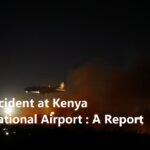WASHINGTON, D.C. — A mid-air collision between an American Airlines passenger jet and a U.S. Army Black Hawk helicopter over the Potomac River on Thursday afternoon has sparked a massive emergency response and raised urgent questions about airspace safety near the nation’s capital. The crash occurred at approximately 3:15 p.m. local time, sending debris plummeting into the river and forcing the shutdown of Reagan National Airport (DCA) and parts of the Potomac airspace.
The Incident: Timeline and Immediate Aftermath
The American Airlines Airbus A320, Flight 2147 en route from Washington, D.C., to Miami with 156 passengers and crew onboard, collided with a UH-60 Black Hawk helicopter carrying five Army personnel during a routine training exercise. Eyewitnesses described a “fireball in the sky” followed by a loud explosion as both aircraft broke apart mid-air.
- Survivors and Casualties: Miraculously, all passengers and crew aboard the Airbus survived after pilots executed an emergency water landing in the Potomac. The helicopter, however, was not as fortunate. Three Army personnel were recovered deceased, while two remain missing as search operations continue.
- Rescue Operations: Coast Guard vessels, local fire departments, and civilian boats rushed to the scene. Passengers were seen evacuating onto inflatable slides and life rafts, with at least 12 hospitalized for minor injuries and smoke inhalation.
Airspace Complexity and Safety Concerns
The Potomac River corridor is one of the most tightly controlled airspaces in the U.S., hosting commercial flights from Reagan National, military aircraft from Joint Base Andrews, and VIP movements, including Marine One for the President. Despite strict protocols, the collision has exposed vulnerabilities:
- Radar Overload: Air traffic controllers manage over 1,000 daily flights at DCA alone, alongside military exercises. Experts suggest overlapping flight paths and communication gaps may have contributed to the tragedy.
- Black Hawk’s Flight Plan: Preliminary reports indicate the helicopter was operating under Visual Flight Rules (VFR) without a filed transponder code, potentially making it “invisible” to commercial radar systems.
- Historical Precedent: The crash echoes the 1982 Air Florida Flight 90 disaster, which also ended in the Potomac, killing 78.
Statement from the National Transportation Safety Board (NTSB):
“We are prioritizing recovery of the flight recorders and radar data. This is a wake-up call for modernizing air traffic systems in congested zones.”
Military and Aviation Responses
- American Airlines: CEO Robert Isom confirmed cooperation with investigators and praised the crew’s “heroic actions” in avoiding a higher casualty count.
- U.S. Army: A spokesperson stated the Black Hawk was part of a “routine urban training drill” and emphasized adherence to safety protocols. The Army has grounded all non-essential flights pending a review.
- FAA Emergency Measures: The FAA imposed a temporary ground stop on DCA and diverted flights to Dulles International (IAD) and Baltimore-Washington (BWI). Enhanced radar tracking for military aircraft in civilian corridors is under discussion.
Eyewitness Accounts and Heroic Efforts
- Jason Carter, Kayaker: “I heard a screeching noise, looked up, and saw the plane’s wing shear off the helicopter. Debris rained down, but the pilots somehow kept the plane steady until it hit the water.”
- Flight Attendant Maria Gonzalez: “We rehearsed for this, but nothing prepares you for the screams. We got everyone out in under 90 seconds.”
Investigation Priorities
The NTSB and FBI (due to the military’s involvement) are focusing on:
- Black Box Analysis: Recovering the Airbus’s cockpit voice recorder and flight data recorder.
- ATC Communication: Reviewing air traffic control logs to determine why the aircraft shared the same altitude (2,800 feet).
- Military-Civilian Coordination: Evaluating procedural gaps between the FAA and Pentagon.
Political Fallout and Calls for Reform
- Senator Mark Warner (D-VA): “This is a systemic failure. We need immediate hearings on integrating military and civilian air traffic technologies.”
- House Transportation Committee Chair: A bipartisan bill to mandate transponder use for all military flights in civilian zones is slated for a vote next week.
The Human Toll
Families of the deceased Army personnel have been notified, while American Airlines passengers recounted harrowing escapes. Among them was Rep. Sheila Jackson Lee (D-TX), who tweeted: “Grateful to be alive. We must honor the fallen by fixing this broken system.”
Conclusion
As dusk fell over the Potomac, salvage crews worked to recover the helicopter’s wreckage, while the nation grappled with the fragility of its airspace safety net. While the Airbus’s survival offers a glimmer of hope, the collision underscores an urgent need for technological upgrades and intersectoral cooperation. For the families of the lost servicemembers and the traumatized passengers, answers—and accountability—cannot come soon enough.












